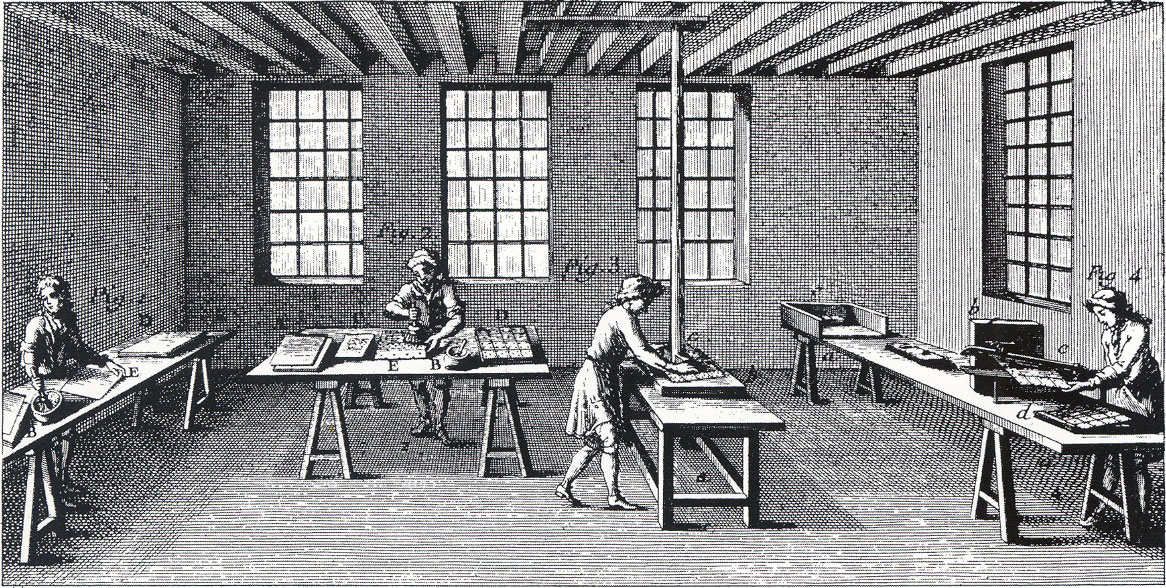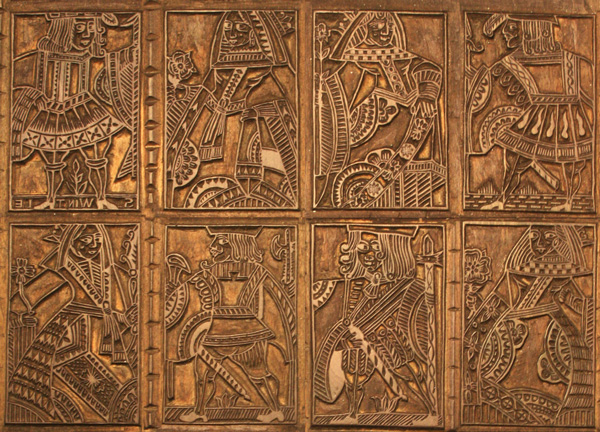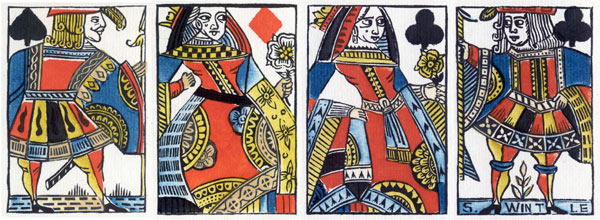Woodblock and Stencil Playing Cards
Around 1987 I decided to make a pack of playing cards from woodblocks and coloured with stencils. I imagined I was carrying out my 'apprenticeship'.
TRADITIONAL ENGLISH PLAYING CARDS
printed from woodblocks
and hand-coloured with stencils

 rom documentary evidence, such as statutes and prohibitions, we get the impression that playing cards were being used in England in the fifteenth century. It is questionable whether these cards were actually made in England from their earliest introduction, so for quite some time they must have been imported. But the 1463 ban on importation leads one to suppose that a domestic industry already existed by this time.
rom documentary evidence, such as statutes and prohibitions, we get the impression that playing cards were being used in England in the fifteenth century. It is questionable whether these cards were actually made in England from their earliest introduction, so for quite some time they must have been imported. But the 1463 ban on importation leads one to suppose that a domestic industry already existed by this time.
Around 1987 I decided to make a pack of playing cards from woodblocks and coloured with stencils. The purpose of the exercise was to acquire insight and practical experience into the circumstantial problems of printing playing cards from woodblocks, their design, colouring with stencils, etc. I was carrying out my 'apprenticeship'.
I acquired the necessary blank wood blocks (lime wood) and had them planed flat and made 'type high'. I then discovered that the woodcutting tools which I had acquired for the task were useless, and so I made my own set out of watchmaker's tools, which are made from higher grade steel.
The Court Cards
The next decision was the model for the court cards. I chose the seventeenth century designs of Hewson, which exemplify the 'English' style which had crystallised by then. Hewson's cards seem very formal and exhibit that geometric construction which characterises the English pattern, as opposed to the earlier cards which had been imported from the continent (by card makers such as Valery Faucil, Pierre Marechal, Jehan Henault, Anthoine Le Cornu, etc.)
Whilst French cards had a tradition of being named after historical personalities, English court cards were never named or based on any historical personalities. The costume worn by the English court pattern came from a French perception of that worn by the monarchy and their attendants, presumably at the time when the designs were first made. This partly explains the strange costumes on the cards, alongside poor copying.
To explain: when copying from an earlier design, or adapting it to a different size or medium, the figures may become 'squeezed' into the desired shape by distorting the limbs, shortening the neck or ankles, and losing the proportions of the original figure, particularly if one is not a very competent artist. We can confirm that English cards are shorter and wider than their French counterparts. Furthermore, when cutting out the designs on the woodblock, perhaps intent on finishing as soon as possible, finer features of the design will be simplified, ignored or removed… in which case the design may become corrupted or modified. English playing cards often look as though this sort of thing has happened. The stencilling is often slap-dash which further obliterates the designs. These reductions in quality are probably due to cost-effectiveness: there is often a sense of expediency. Did this matter?
The English Pattern
Perhaps the problem was compounded in that they weren't always sure exactly what they were representing. It is ironic that embargos had been secured against imported cards, but that home-produced ones were so badly designed! However, due to the formalisation of the designs, and whether they are called 'packs' or 'decks', today the English pattern has become the leading international pattern. The Americans took it with them and perpetuated it over there, although they introduced innovations including the joker and (probably) corner indices►
THE PIP CARDS
There is more to making a pack of playing cards than designing and printing the court cards… namely the pip cards. The stencils were made from heavy, oiled card and the pips were cut with punches which I had specially made. I believe that this is how they were traditionally made, otherwise there would have been noticeable variations between adjacent pips had they been cut out by hand.
With the benefit of hindsight I can now see where I made mistakes, particularly at the colouring stage. It was fascinating to rediscover why the old card makers did things in particular ways, which may appear odd or eccentric until we try to do it differently. Then we see the logic!
The wrappers were printed from woodblocks with letterpress overprinting. The backs were plain white, as they were traditionally.
Alternative Colour Scheme

Above: during the stencilling stage I also tried alternative colour schemes.
See also: Amos Whitney's Factory Inventory Chromolithography Design of Playing Cards Make your own Playing Cards Letterpress Printing Manufacture of Cardboard Manufacture of Playing Cards, 1825 Rotxotxo Workshop Inventories, Barcelona The Art of Stencilling


By Simon Wintle
Member since February 01, 1996
I am the founder of The World of Playing Cards (est. 1996), a website dedicated to the history, artistry and cultural significance of playing cards and tarot. Over the years I have researched various areas of the subject, acquired and traded collections and contributed as a committee member of the IPCS and graphics editor of The Playing-Card journal. Having lived in Chile, England, Wales, and now Spain, these experiences have shaped my work and passion for playing cards. Amongst my achievements is producing a limited-edition replica of a 17th-century English pack using woodblocks and stencils—a labour of love. Today, the World of Playing Cards is a global collaborative project, with my son Adam serving as the technical driving force behind its development. His innovative efforts have helped shape the site into the thriving hub it is today. You are warmly invited to become a contributor and share your enthusiasm.
Related Articles

Luditz Pattern by Georg Geiselreiter
The discovery of 2024 changes the current state of knowledge of the history of this pattern.

Scientific Whist
“Scientific Whist” : standard cards with instructions for play on the faces by Chas Goodall & Son, 1...

Agent Provocateur
Branded lingerie collection in a pack of pin-up playing cards.

Nimbus playing cards
Mike Steer’s weather-themed pack with suits in four colours and backs for cardistry.

Agatha Christie and Playing Cards revisited
Agatha Christie uses card-play as a primary focus of a story, and as a way of creating plots and mot...

The Decadent Deck
Studies in the eroticism of the female body by Inge Clayton.

Historic Shakespeare
“Historic Shakespeare” playing cards featuring Shakespearean characters by Chas Goodall & Son.

Copechat Paramount Sorting System
Preserving the past: a specimen deck showcasing edge-notched cards and their ingenious sorting syste...

Heartsette by Herbert Fitch & Co, 1893
A glimpse into a busy print and design office in late Victorian London.

Batman® playing cards
Batman playing cards published by InterCol of London 1989.

Can You Believe Your Eyes?
“Can You Believe Your Eyes?” playing cards featuring visual illusions & other oddities.

Pastime Playing Cards for the Blind
The “Pastime” Playing Cards for the Blind manufactured by Goodall & Son Limd., c.1910.

Songs with Flute accompaniment
Eighteenth century English engraved cards with music for voice and flute.

Love Tests
Vintage novelty “Love Test” cards of a slightly saucy nature but all in good fun!

Ben 10 playing cards
Characters from the American animated television science fantasy series Ben 10.

Doctor Who Trump Card Game
Game for two players in which Doctor Who and the Legendary Legion join battle with the Alien Hordes....
Most Popular
Our top articles from the past 28 days



